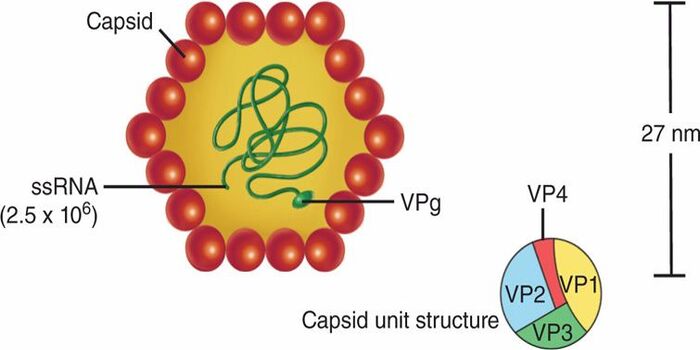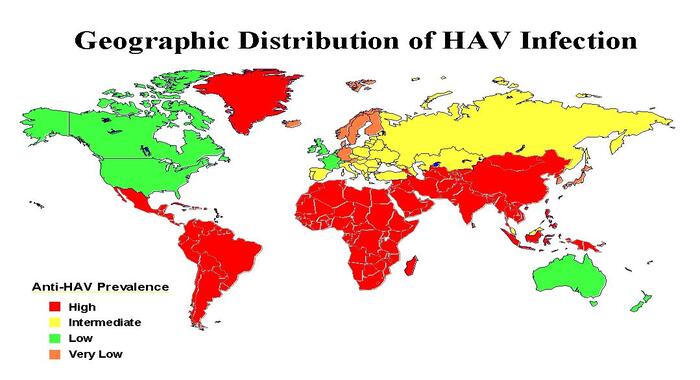What is Hepatitis?
Table of Contents
hide
- ‘Hepatitis’ means inflammation or swelling of the liver.
- The liver is a vital organ that processes nutrients, filters the blood, and fights infections. When the liver is inflamed or damaged, its function can be affected.
- The most common types of viral hepatitis are Hepatitis A, Hepatitis B, and Hepatitis C. Heavy alcohol use, toxins, some medications, and certain medical conditions can also cause hepatitis.
What is Hepatitis A Virus?
- Hepatitis A is an inflammation of the liver caused by the hepatitis A virus (HAV).
- The disease can range from a mild illness lasting a few weeks to a severe illness lasting several months.
- It is transmitted by eating contaminated food and water, or by direct contact with the infected person.
Structure of Hepatitis A Virus
- The hepatitis A virus belongs to the genus Hepatovirus and is a distinct member of the picornavirus family.
- HAV is a 27 to 32 nm spherical particle with icosahedral symmetry containing a linear single-stranded RNA genome with a size of 7.5 kb and is non-enveloped.

Source:Dr. J. H. Hoofnagle and of Abbot Laboratories, Diagnostic Division, North Chicago, Illinois
- It floats at a primary density of 1.32 to 1.34 g/cc in CsCl and sinks to a sedimentation coefficient of 156 to 160 S in neutral sucrose solutions.
Genome of Hepatitis A Virus
- HAV can be divided into three parts.
- an uncapped 5′ noncoding region (NCR) that makes up around 10% of the genome and is covalently connected to the viral protein VPg at its 5′ terminus.
- a single open reading frame, designated P1 for capsid proteins and P2 and P3 for nonstructural proteins, that appears to encode all of the viral proteins.
- a short 3′ NCR terminating in a polyA tail.
- The structural proteins that make up the capsid protein are divided into four segments in region P1: 1A-VP4, 1B-VP2, 1C-VP3, and 1D-VP1.
- Three non-structural proteins, 2A, 2B, and 2C, make up P2 and are involved in viral replication.

Source:Totsuka and Moritsugu; Intervirology 1999; 42: 63.
- There are four non-structural proteins in P3.
- 3A: provides a cell membrane anchor for the replication complex.
- 3B: The protein is VPg.
- 3C: The enzyme cysteine protease separates proteins from polypeptides.
- This RNA polymerase is RNA-dependent.
Epidemiology of Hepatitis A Virus

Source:http://virology-online.com/viruses/HepatitisA.htm
- Hepatitis A occurs throughout the world.
- It is extremely endemic in several regions, including Africa, the Middle East, Asia, the Western Pacific, Central and South America, and Africa.
Transmission of Hepatitis A Virus
The virus is transmitted in several ways:
- The virus is found in the stool (faeces) of people with hepatitis A and is spread when someone’s stool gets into food or water.
- Eating foods made by a person infected with the virus who did not wash hands well after the use of toilets.
- Drinking contaminated water.
- Eating contaminated raw, frozen, or undercooked food.
- Direct contact with the infected person, even if no symptoms are present.
- Sexual contact with an infected person.
- Touching contaminated surfaces and then placing your hands near or in the mouth.
Who is at risk for Hepatitis A?
Although anyone can get Hepatitis A, some people are at greater risk, such as those who:
- Travel to or live in areas where hepatitis A is common.
- Have sexual contact with someone who has Hepatitis A.
- Live with someone who has hepatitis A.
- Are men who have sex with men.
- Have clotting-factor disorders, such as haemophilia.
- Have sexual contact with someone who has hepatitis A
What are the symptoms of Hepatitis A?
Not everyone has symptoms. If symptoms develop, they usually appear 2–6 weeks after the infection and can include:
- Tiredness
- Abdominal pain
- Joint pain
- Nausea, vomiting, and diarrhoea
- Fever
- Loss of appetite
- Light or grey-coloured stools
- Jaundice (yellowing of the skin or eyes)
Lab Diagnosis of Hepatitis A Virus
Sample: blood, stool, bile, liver biopsy, serum
1. Antigen detection
- Detection using PCR and nucleic acid hybridization assay.
2. Antibody detection
- A demonstration of IgM antibodies to the virus, which are nearly always present at the beginning of symptoms and continue to exist for up to 6 months after infection.
- IgG antibody serves as a helpful measure of immunity and typically lasts for several years.
- The enzyme-linked immunosorbent test (ELISA) is used to detect antibodies.
3. Liver function test
- A liver function test measures the amount of serum bilirubin, ALT, ALP, and GGTP, among other liver enzymes.
Treatment of Hepatitis A Virus
- There is no specific treatment for hepatitis A. It is usually recommended to maintain good nutrition, get plenty of rest, drink fluids, and avoid alcohol and certain medications that affect the liver, such as acetaminophen, paracetamol, and antiemetic drugs.
- Recovery may be quite slow, and it may take several weeks or months. After recovery, the person will gain immunity against this disease for life.
What can be done to avoid giving Hepatitis A to others?
If you have hepatitis A Virus:
- Wash your hands thoroughly with soap and warm water; dry on a clean towel.
- Do not prepare food or drink for other people.
- Do not share eating or drinking utensils with other people.
- Do not share linen and towels with other people.
- Do not have sex.
- Wash eating utensils in soapy water, and machine wash linen and towels.
Complications of Hepatitis A Virus
- It is important to note that the complications of Hepatitis A are rare. However, in some cases, the virus can lead to acute liver failure, which may require a liver transplant for treatment.
- It is crucial for individuals who are at higher risk, such as the elderly or those with pre-existing liver conditions, to take extra precautions to prevent the spread of the virus.
Prevention and Control of Hepatitis A Virus
- Wash hands thoroughly with soap and water, especially before eating or preparing food or drinks and after using the bathroom or changing diapers.
- Avoid raw or undercooked shellfish.
- Only drink safe, treated water. Do not swallow water in pools, lakes, rivers, etc.
- Do not swim when you have diarrhoea.
- Practice safe food handling: wash all fruits and vegetables, cook meats well, and keep raw meats and their juices away from other food.
- Use condoms correctly and every time you have sex.
- Get vaccinated: The best way to prevent hepatitis A is to get vaccinated. The vaccine is very effective and can keep you from ever getting hepatitis A.
References
- Hepatitis A Virus- An Overview: Microbe Notes
- Hepatitis A Virus: Structure, Pathogenesis, and Diagnosis: Microbe Online
- https://www.sciencedirect.com/science/article/abs/pii/S0889855320300029?via%3Dihub
- https://journals.asm.org/doi/10.1128/cmr.19.1.63-79.2006
- https://perspectivesinmedicine.cshlp.org/content/8/12/a033480
